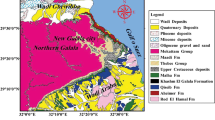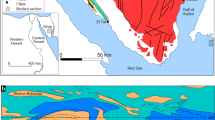Abstract
Microfossil analysis was carried out on 90 samples of a sediment core from Grossensee. The diversity of subfossil Cladocera, Chironomidae, Chaoborus, and Ostracoda reflects at least five different stages of development. Three extended cycles correspond to different climatic periods in the first 10 000 years of the lake's history, while during the last 2 000 years, two shorter cycles can be identified which correlate with proofs or even historical events for human activity in the catchment area. During this time the profundal fauna changed from stenoxibiontic to euryoxibiontic species. In the planktonic fauna a succession of three Eubosmina types, B. longispina, B. coregoni kessleri, and B. coregoni coregoni, was observed. The chydorid and ostracod assembly of the littoral showed no clear change.
Similar content being viewed by others
References
Averdieck, F.-R., 1983. Palynological investigations of the sediments of ten lakes in Eastern Holstein, North Germany. Hydrobiologia, this volume.
Diebel, K. & Pietrzeniuk, E., 1975. Mittel- and jungpleistozäne Ostracodenfauna des Raumes Potsdam-Brandenburg-Rathenau in stratigraphischer und ökologischer Sicht. Z. geol. Wiss. Berlin 3: 1197–1233.
Flössner, D., 1972. Kiemen- and Blattfüsser, Branchipoda, Fischläuse Brachiura. In: Dahl, M. & Peus, F. (eds.). Die Tierwelt Deutschlands 60: 1–499.
Frey, D. G., 1959. The taxonomic and phylogenetic significance of the head pores of the Chydoridae (Cladocera). Int. Revue ges. Hydrobiologia 44: 27–50.
Hingst, H., 1959. Vorgeschichte des Kreises Storman. Wachholtz, Neumünster.
Hofmann, W., 1971. Die postglaziale Entwicklung der Chironomiden and Chaoborus Fauna (Dipt.) des Schöhsees. Arch. Hydrobiol. Suppl. 40: l-74.
Hofmann, W., 1971. Zur Taxonomie and Palökologie subfossiler Chironomiden (Dipt.) in Seesedimenten. Arch. Hydrobiol. Beih. Ergebn. Limnol. 6: l-50.
Hofmann, W., 1978. Analysis of animal microfossils from Grosser Segeberger See (F.R.G.). Arch. Hydrobiol. 82: 316–346.
Klie, W., 1938. Ostracoda, Muschelkrebse. In: Die Tierwelt Deutschlands. Dahl, Jena 34: 1–230.
Löffler, H., 1967. Ostracoda. In: Illies, J. (ed.). Limnofauna Europaea. Enke, Stuttgart: 162–172.
Ohle, W., 1972. Die Sedimente des Grossen Plöner Sees als Dokumente der Zivilisation. Jb. Heimatkunde Kreis Plön. 2: 7–27.
Thienemann, A., 1954. Chironomus. Die Binnengewässer 20: 1–834.
Author information
Authors and Affiliations
Rights and permissions
About this article
Cite this article
Günther, J. Development of Grossensee (Holstein, Germany): variations in trophic status from the analysis of subfossil microfauna. Hydrobiologia 103, 231–234 (1983). https://doi.org/10.1007/BF00028457
Issue Date:
DOI: https://doi.org/10.1007/BF00028457




